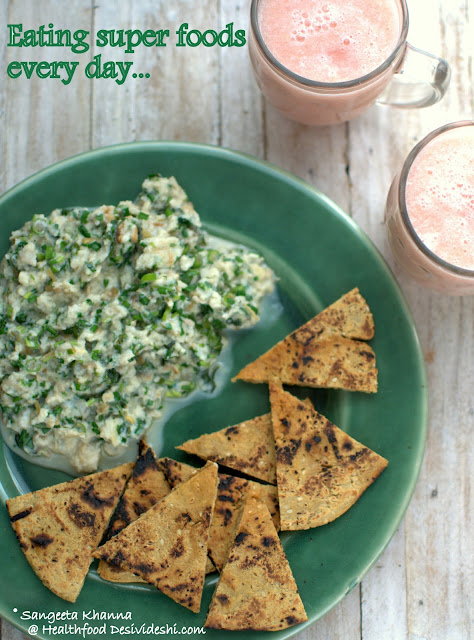A simple regular egg scramble takes about 5 minutes to make and a millet based pita bread can take another 10-15 minutes depending on your roti making skill. Blending pomelo segments to make a smoothie-juice takes another 5 minutes, including cleaning your blender. In about 20 minutes a super food breakfast can be whipped up and this platter of egg scramble with loads of chives and rucola, sorghum pita bread and pomelo (grapefruit) smoothie was our weekend late breakfast last week.
Wondering why I am talking about super foods so often these days?
I know you have questioned the relevance of super foods and have wondered about what foods are super foods and which ones are 'just regular food'. High time we analysed our 'just regular foods' and took a hard look on super foods. Don't you think we need the so called super foods more because we have fallen for junk foods? The more we eat junk foods the more we feel like compensating with some super power..err..super foods.
And lo and behold, the same markets that trapped us into the 'junk food' addiction, are shoving super foods down our throats. And we end up eating the extra large sized junk burgers, gripped by guilt later we buy a pack of some newly introduced (to our part of the world) berries and seeds and try and undo the burger guilt. Oh and we overlook everything else that might have been on our table in a normal way. The 'just regular food' that may be equivalent to the newly crowned super food is often ignored as there are stronger market forces pushing us towards a certain new product.
But the good thing is, we can decide better.
It will help to know that using herbs and some spices can boost up the super food quotient of any 'just regular meal' by several notches.
Here are a few ways you can make a regular meal antioxidant rich, and get it qualify as super food.
- a pinch of clove powder has enough antioxidants as a handful of berries. Add it to your regular banana smoothie if you don't have blueberries. See this to believe.
- adding some basil or tulsi leaves to the smoothie or salad would be even better than blueberries.
- a generous dash of black pepper would help absorb nutrients better and make a regular bowl of vegetable or fruit salad much more nutrition efficient.
- amla or Indian gooseberry blended with ginger and curry leaves in a glass of buttermilk is packed with super foods of different categories.
- Think of turmeric, ginger, fenugreek, regular curry powder and even green chutneys and how these have been making Indian meals healthier for centuries.
- some very easily available leaves like curry leaves, drumstick leaves, purslane, sweet potato leaves, beet leaves and even turnip and radish leaves are full of antioxidants and minerals that one finds in expensive imported berries and exotic leafy greens.
See how easily drumstick leaves combine with scrambled eggs to make a delicious meal in a hurry.
And once you pair this breakfast with a millet bread it become better, a glass of grapefruit or citrus juice makes it even better. If not juice it could be this amla infused buttermilk.
Recipe of the creamy and herb loaded egg scramble..
ingredients
(2 servings)
4 eggs
1/2 cup chopped garlic chives
1/4 cup rucola leaves (or use coriander greens or spring onions)
1 tbsp or a bit more roughly chopped mature cheddar
salt and pepper to taste
3 tbsp milk (you can use butter too)
procedure..
Pour the milk in the pan first, break the eggs directly in the pan and dump in all the ingredients together. Whisk a little, lower the heat to minimum and cover for a minute or so.
Uncover, scramble the soft set eggs till it reaches the desired consistency. Serve immediately.
I used to cook my egg scramble in milk during my research days when I would teach in the early morning hours and then would reach the lab around 9 AM. I would buy milk, eggs, bread and fruits for on the way and cook a quick egg scramble with bread as soon as I reached my lab. Since this was cooked over a simple heater with minimal ingredients and utensils I used to add milk to eggs and quickly stir to scramble them. That became my favourite method to scramble eggs later. My sandwiches were famous among my lab mates by the way.
Recipe of the jowar (sorghum pita)..
ingredients..
(makes 2 large round pita breads, enough for 2-3 servings)
a cup of jowar flour
1/2 cup of yogurt
pinch of soda bicarb
pinch of salt
a cup of hot water
procedure
Add salt and soda bi carb to the flour and whisk to mix. Pour the yogurt and whisk again as it becomes a crumbly dough.
Now add hot water slowly and knead a soft dough while massaging the dough in quick movements.
Heat a griddle, divide the dough into two parts, roll out a flat bread between 2 sheets of cling film or pat a thick roti using your palms. I do just that.
Slap the roti on hot griddle and let it cook both sides. The roti (flat bread) would come off the hot griddle as soon as it cooks, if it keeps sticking to the pan it means it is yet to cook. Give it come more time and it comes off.
Bake it some more over open flame and cut into wedges of halves as per convenience.
Alternatively, the rolled out roti can be baked in the oven till done. On the griddle it takes hardly 5 minutes but in the oven it will take about 25 minutes to bake.
Any leftover jowar roti or pita bread can be crumbled with ghee and jaggery to make instant dessert, the peasant way.
High time we started eating the peasant way.










































